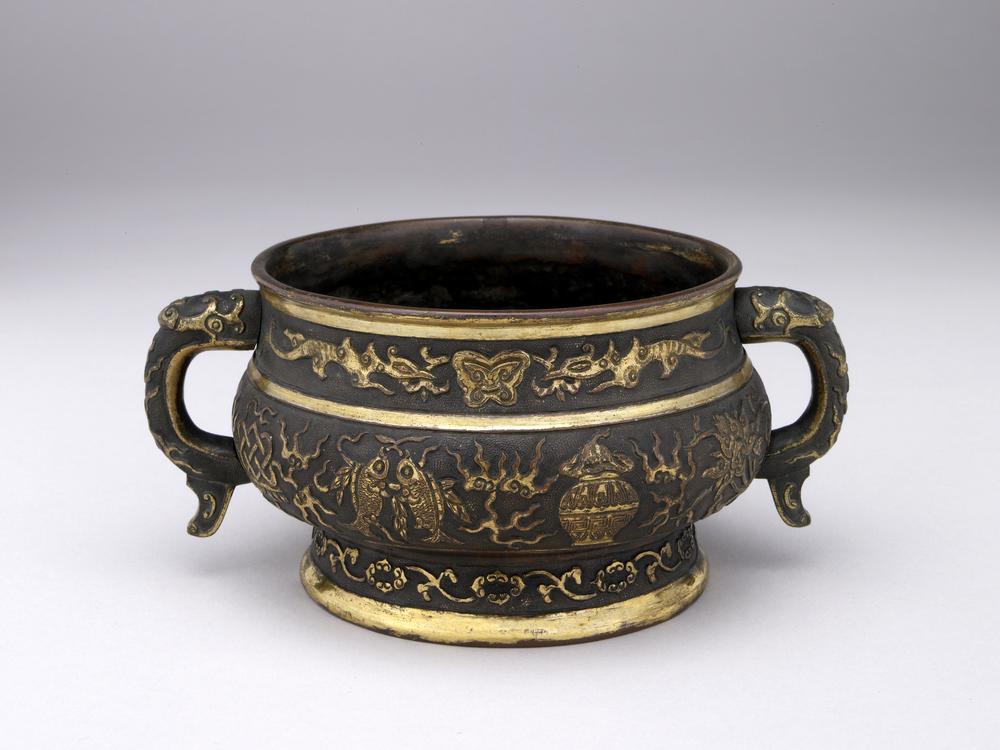Period:Unknown Production date:1666
Materials:silk
Technique:painted
Subjects:landscape,flower deity myth/legend equestrian
Dimensions:Height: 31.70 centimetres Width: 587.90 centimetres
Description:
Painting, handscroll. Six miscellaneous pictures: 1. View of West Lake 2. Eight Views of the Xiao and Xiang Rivers 3. Plants-and-insects: butterflies, dragonflies, and other insects around cotton roses, chrysanthemums, bush clover, and eulalia 4. Five of the Seven Gods of Good Fortune: Benzaiten, Daikokuten, Hotei, Ebisu, and Bishamonten 5. Scythian hunter on horse back drawing bow at wild geese flying across sky 6. Shoki (Zhong Kui) riding on Chinese lion, looking at geese. Ink and colour on silk. Signed, dated and sealed.
IMG
![图片[1]-painting; handscroll BM-1979-0723-0.10-China Archive](https://chinaarchive.net/Unknown/Paintings/mid_00031320_001.jpg)
![图片[2]-painting; handscroll BM-1979-0723-0.10-China Archive](https://chinaarchive.net/Unknown/Paintings/mid_00538409_001.jpg)
Comments:Hizo Nihon bijutsu taikan Vol 2This scroll of miscellaneous pictures begins with a picture of West Lake (Xihu), famed for its beautiful scenery (Color Plate 36-1). Stretching in a straight line across the water is the dike said to have been built when Su Dongpou was prefect of Hangchou. The scene soon changes to the Eight Views of the Xiao and Xiang Rivers (Color Plate 36-2). These (not illustrated here) are in a graceful, atmospheric style strongly contrasting with the stiff, formal style of the scene of West Lake.The scroll abruptly abandons landscape for a plants-and-insects scene (Color Plate 36-3). The style, too, changes from now on to a compromise between the stiff and the atmospheric. On a mild, Indian-summer’s day, butterflies, dragonflies, and other insects are disporting themselves around cotton roses, chrysanthemums, bush clover, and eulalia. From natural history, the scroll turns to human figures in the form of five of the (conventionally seven) Gods of Good Fortune: Benzaiten, Daikokuten, Hotei, Ebisu, and Bishamonten. Again the scene changes, this time to one of a Scythian hunting. Bow drawn to the full, he is taking aim at wild geese flying across the sky. The scroll ends with Shoki the demon slayer; riding on a Chinese-style lion, he is gazing out of the corner of his eye at the same geese as the Scythian was after – an interesting compositional conceit to end the scroll.Kano Tan’yu died in 1674 at the age of seventy-three, which means that this scroll was painted eight years before his death. This kind of work, known as a “miscellaneous scroll,” combines all the three major genres – landscape, human figures, and flower-and-bird themes. It would seem that it was originated, or at least raised to the point of artistic viability, by Tan’yu himself. Standing on the threshold of the Edo period, he made a large number of new painting experiments, among which this particular form may perhaps be numbered.
Materials:silk
Technique:painted
Subjects:landscape,flower deity myth/legend equestrian
Dimensions:Height: 31.70 centimetres Width: 587.90 centimetres
Description:
Painting, handscroll. Six miscellaneous pictures: 1. View of West Lake 2. Eight Views of the Xiao and Xiang Rivers 3. Plants-and-insects: butterflies, dragonflies, and other insects around cotton roses, chrysanthemums, bush clover, and eulalia 4. Five of the Seven Gods of Good Fortune: Benzaiten, Daikokuten, Hotei, Ebisu, and Bishamonten 5. Scythian hunter on horse back drawing bow at wild geese flying across sky 6. Shoki (Zhong Kui) riding on Chinese lion, looking at geese. Ink and colour on silk. Signed, dated and sealed.
IMG
![图片[1]-painting; handscroll BM-1979-0723-0.10-China Archive](https://chinaarchive.net/Unknown/Paintings/mid_00031320_001.jpg)
![图片[2]-painting; handscroll BM-1979-0723-0.10-China Archive](https://chinaarchive.net/Unknown/Paintings/mid_00538409_001.jpg)
Comments:Hizo Nihon bijutsu taikan Vol 2This scroll of miscellaneous pictures begins with a picture of West Lake (Xihu), famed for its beautiful scenery (Color Plate 36-1). Stretching in a straight line across the water is the dike said to have been built when Su Dongpou was prefect of Hangchou. The scene soon changes to the Eight Views of the Xiao and Xiang Rivers (Color Plate 36-2). These (not illustrated here) are in a graceful, atmospheric style strongly contrasting with the stiff, formal style of the scene of West Lake.The scroll abruptly abandons landscape for a plants-and-insects scene (Color Plate 36-3). The style, too, changes from now on to a compromise between the stiff and the atmospheric. On a mild, Indian-summer’s day, butterflies, dragonflies, and other insects are disporting themselves around cotton roses, chrysanthemums, bush clover, and eulalia. From natural history, the scroll turns to human figures in the form of five of the (conventionally seven) Gods of Good Fortune: Benzaiten, Daikokuten, Hotei, Ebisu, and Bishamonten. Again the scene changes, this time to one of a Scythian hunting. Bow drawn to the full, he is taking aim at wild geese flying across the sky. The scroll ends with Shoki the demon slayer; riding on a Chinese-style lion, he is gazing out of the corner of his eye at the same geese as the Scythian was after – an interesting compositional conceit to end the scroll.Kano Tan’yu died in 1674 at the age of seventy-three, which means that this scroll was painted eight years before his death. This kind of work, known as a “miscellaneous scroll,” combines all the three major genres – landscape, human figures, and flower-and-bird themes. It would seem that it was originated, or at least raised to the point of artistic viability, by Tan’yu himself. Standing on the threshold of the Edo period, he made a large number of new painting experiments, among which this particular form may perhaps be numbered.
© Copyright
The copyright of the article belongs to the author, please keep the original link for reprinting.
THE END
![[Qing Dynasty] British female painter—Elizabeth Keith, using woodblock prints to record China from the late Qing Dynasty to the early Republic of China—1915-China Archive](https://chinaarchive.net/wp-content/uploads/2022/11/image-191x300.png)




